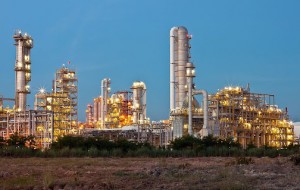Not all FKM rubber compounds are the same. People in the industry often refer to all FKM or fluoroelastomer rubbers as Viton®. Viton® is a trade name for the polymer once owned by Dupont™ that is now sold by Chemours™. There are a few different suppliers of FKM polymers, but they use other trade names for the polymer.
FKM Rubber Formulation
FKM rubber formulations typically have polymer, filler, activator, processing aid, and curatives. These formulations are more simplified than EPDM or NBR compounds. Due to the material’s high performance, the polymer gives the most physical and chemical characteristics, so ingredient loading is less. High-end compounds won’t have plasticizers that extract or burn off at high temperatures. As with most formulations, it is a parts per 100 (PHR) polymer.
Ingredient PHR
Polymer 100
Acid Acceptor 0 – 6
Fillers 5 – 60
Processing Aids 0 – 2
Cure System 1 – 8
Polymer: Dipolymer, Terpolymer or special.
Acid Acceptors: Magnesium Oxide, Calcium Hydroxide, Zinc Oxide
Fillers: Carbon Black, Clay, Barium Sulfate
Processing Aids: Paraffin Wax, Fatty Acids, Silicone
Cure System: Bisphenol, Peroxide, Co-agents
Polymer Types
Chemours Viton® uses three different designations: A, B, or F type polymers. The difference is in the polymer’s fluorine levels, which relates to its resistance to attack by fluids or chemicals. The two methods of curing are bisphenol and peroxide. An identifying difference between these polymers is the volume swell in methanol or low molecular weight oxygenated solvents. For example, if an FKM rubber is immersed in methanol for 168 hrs at 23°C, you can expect to have swells close to 90% for A, 40 % for B, and 5% for F. This is an excellent test for determining what type of polymer is being used.
A type or ASTM D1418 FKM Type 1: Dipolymer of hexafluoropropylene (HFP) and Vinylidene Fluoride (VF2).
B and F Type or ASTM D1418 FKM Type 2: Terpolymer of HFP and VF2 with Tetrafluoroethylene (TFE).
ASTM D1418 FKM Type 3 – Low Temperature FKM uses a fluorinated vinyl ether monomer. Depending on the polymer can be similar chemical resistance as A or F type.
ASTM D1418 FKM Type 5 – is a tetra polymer of ethylene, tetrafluoroethylene (TFE) and perfluoromethyl vinyl ether (PMVE). This combination gives outstanding chemical resistance.
Polymer Producers
Chemours – Viton
Daikin Chemical – Dia-El
3M Dyneon – Dyneon *Will discontinue production in 2025
Solvay Speciality Polymers – Tecnoflon
Chemical Resistance
| Polymer Type | |||||||
| Application Contact: | A | B | F | GF | GLT | GFLT | ETP |
| Cure System | Bisphenol | Peroxide | |||||
| Aliphatic Hydrocarbons | 1 | 1 | 1 | 1 | 1 | 1 | 1 |
| Aromatic Hydrocarbons | 2 | 1 | 1 | 1 | 2 | 1 | 1 |
| Automotive fuels (NO Alcohol) | 1 | 1 | 1 | 1 | 1 | 1 | 1 |
| Automotive Fuels (5 to 15% Alcohol) | 2 | 1 | 1 | 1 | 2 | 1 | 1 |
| Automotive Fuels (up to 100% Alcohol) | NR | 2 | 1 | 1 | NR | 1 | 1 |
| Engine Lubricating Oils (SE-SF grades) | 2 | 1 | 1 | 1 | 1 | 1 | 1 |
| Engine Lubricating Oils (SG-SH grades) | 3 | 2 | 2 | 1 | 1 | 1 | 1 |
| Acid, Hot Water, Steam | 3 | 2 | 2 | 1 | 1 | 1 | 1 |
| Strong Base, High PH, Amines | NR | NR | NR | NR | NR | NR | 2 |
| Low Molecular Weight Carbonyls – (MTBE, MEK, MIBK) | NR | NR | NR | NR | NR | NR | 2 |
| Low Temperature Flexibility (TR-10) ‘C | -17 | -14 | -7 | -6 | -30 | -24 | -11 |
1 – Little to Minor Effect, 2 – Minor To Moderate Effect, 3 – Moderate to Severe Effect , NR- Not Recommended
Applications
Industrial Uses
- O-rings
- Vacuum seals
- Heat and corrosion resistant expansion joints
- Packing rings for hydraulics
- High precision molded balls for check valves
- Chemical resistant grommets
- Automotive seals for flex fuels
Aerospace
- O-rings
- Exhaust Housing Seals
- Low Outgassing Seals
Fluid Power
- Hydraulic seal – U-cups, V-packing rings
- Pump Seals
Medical
- Low friction pump seals
- Non-leaching chemical seals
- Sanitary Gaskets
Apple Rubber molds many different polymer types for various applications and industries. We recommend asking us which polymer is correct for your application. Not all FKM compounds are the same. Changing polymer type and cure systems can make your part go from failure to success. FKM compounds can be used up to 300°C for a short period of time and down to -54°C for some static applications.
